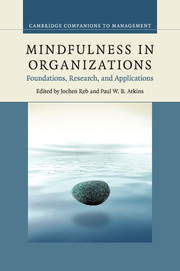Book contents
- Frontmatter
- Contents
- List of figures
- List of tables
- List of contributors
- Foreword
- Preface
- Part I Foundations
- Part II Research
- Part III Applications
- 14 Awakening at work: introducing mindfulness into organizations
- 15 Teaching managers to manage themselves: mindfulness and the inside work of management
- 16 Mindfulness in coaching
- Index
- References
16 - Mindfulness in coaching
from Part III - Applications
Published online by Cambridge University Press: 05 July 2015
- Frontmatter
- Contents
- List of figures
- List of tables
- List of contributors
- Foreword
- Preface
- Part I Foundations
- Part II Research
- Part III Applications
- 14 Awakening at work: introducing mindfulness into organizations
- 15 Teaching managers to manage themselves: mindfulness and the inside work of management
- 16 Mindfulness in coaching
- Index
- References
Summary
Today we are so inter-dependent, so closely interconnected with each other, that without a sense of universal responsibility, a feeling of universal brotherhood and sisterhood, and an understanding and belief that we are really part of one big human family, we cannot hope to overcome the dangers of our very existence – let alone bring about peace and happiness.
The Dalai Lama (2006, p. 18)
Introduction
Coaching is a global phenomenon. In 2009, there were an estimated 43,000 business coaches worldwide (Bresser 2009), up from an estimated 30,000 business coaches in 2006 (International Coach Federation 2014). Executive coaching is informed by a broad range of theoretical frameworks (Passmore 2005) and, as coaching has become more established, the diversity of coaching forms has grown. In recent years, mindfulness has increasingly been used within coaching.
One reason for the rise in interest is the adaptation and introduction of mindfulness into varied secular settings, including politics, education, psychotherapy, and the workplace. The UK Government's National Institute for Health and Clinical Excellence's 2009 recommendation of mindfulness-based cognitive therapy (MBCT) for the treatment of recurrent depression has given mindfulness a stamp of approval that has influenced mindfulness-based coaching.
The expanding research highlighting an array of benefits to be gained from practicing mindfulness is naturally contributing to this growth in interest. Coaches seek to optimize clients’ functioning and to help clients reach their full potential, so it follows that they will be interested in approaches and techniques that will support the achievement of these aims.
Meanwhile, mindfulness is being heralded by many as a welcome antidote to widespread mindlessness in these challenging and complex times (e.g. Cavanagh and Spence 2013). Many crises continue to play out; poor ethical behaviour is widespread (Chartered Management Institute 2013); stress levels are higher than ever (Chartered Institute of Personnel and Development 2013), and our mindless excessive consumption is threatening our very existence.
- Type
- Chapter
- Information
- Mindfulness in OrganizationsFoundations, Research, and Applications, pp. 383 - 408Publisher: Cambridge University PressPrint publication year: 2015



